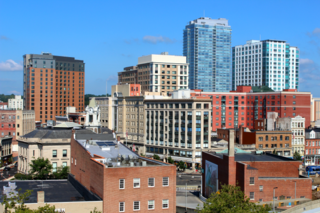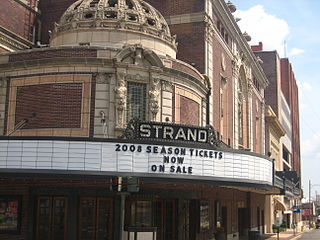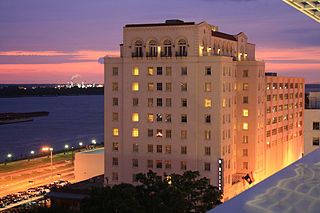
McKinley Senior High School, located in Baton Rouge, Louisiana, United States on 800 E. McKinley St., is home to the East Baton Rouge Parish School Board's first gifted and talented high school programs. The school mascot is a Panther and the school colors are royal blue and white.

Spanish Town is a historic district anchored by Spanish Town Road in Baton Rouge, the capital city of the U.S. state of Louisiana. It is well known for its annual Mardi Gras parade, which is the largest in Baton Rouge.
The Garden District is a residential neighborhood located in Baton Rouge's Mid-City area where Park Boulevard intersects Government Street. The Garden District is an established historic area with many upscale homes and an active civic association.

Downtown Stamford, or Stamford Downtown, is the central business district of the city of Stamford, Connecticut, United States. It includes major retail establishments, a shopping mall, a university campus, the headquarters of major corporations and Fortune 500 companies, as well as other retail businesses, hotels, restaurants, offices, entertainment venues and high-rise apartment buildings.

Theodore C. Link, FAIA, was a German-born American architect and newspaper publisher. He designed buildings for the 1904 World's Fair, Louisiana State University, and the Mississippi State Capitol.

The Strand Theatre in Shreveport, Louisiana, United States, opened in 1925 as a Vaudeville venue and was nicknamed "The greatest theatre of the South" and the "Million Dollar Theatre" by its builders, Julian and Abraham Saenger of Shreveport, owners of the Saenger Amusements Company, which operated theaters throughout the American South and in Central America. By the 1940s it had evolved into a movie cinema, which it remained until its closure in 1977. Threatened with demolition, it was saved by a coalition of concerned citizens who restored it to its original grandeur over a nearly seven-year period. It is the "Official State Theatre of Louisiana". Since its re-opening in 1984 following restoration it has served as a performing arts venue, featuring the Shreveport Broadway Series and other traveling Off-Broadway shows.

The Old Louisiana State Capitol, also known as the State House, is a historic government building, and now a museum, at 100 North Boulevard in Baton Rouge, Louisiana, U.S.A. It housed the Louisiana State Legislature from the mid-19th century until the current capitol tower building was constructed from 1929-32.

The Pentagon Barracks, also known as the Old United States Barracks, is a complex of buildings located at the corner of State Capitol Drive and River Road in Baton Rouge, Louisiana, in the grounds of the state capitol. The site was used by the Spanish, French, British, Confederate States Army, and United States Army and was part of the short-lived Republic of West Florida. During its use as a military post the site has been visited by such notable figures as Zachary Taylor, Lafayette, Robert E. Lee, George Custer, Jefferson Davis, and Abraham Lincoln.

The Old Louisiana Governor's Mansion is located at 502 North Blvd. between Royal and St. Charles Streets in Baton Rouge and was used as Louisiana's official gubernatorial residence between 1930 and 1963; a new residence was completed in 1963. The Old Governor's Mansion was built under the governorship of Huey Long, its first resident. The building is reported to be inspired by the White House in Washington D.C. as it was originally designed by Thomas Jefferson. It is said that Long wanted to be familiar with the White House when he became president, so he had the White House duplicated in Baton Rouge. Some dispute this legend and simply say that the building is merely a fine example of a Georgian-style mansion.

The Magnolia Mound Plantation House is a French Creole house constructed in 1791 near the Mississippi River in Baton Rouge, Louisiana. Many period documents refer to the plantation as Mount Magnolia. The house and several original outbuildings on the grounds of Magnolia Mound Plantation are examples of the vernacular architectural influences of early settlers from France and the West Indies. The complex is owned by the city of Baton Rouge and maintained by its Recreation Commission (BREC). It is located approximately one mile south of downtown.

Magnolia Cemetery is a 10-acre (4.0 ha) cemetery in Baton Rouge, Louisiana.
Baton Rouge, Louisiana has many historic neighborhoods, dating back as far as the early 19th century.

This is a list of the National Register of Historic Places listings in East Baton Rouge Parish, Louisiana.

The Hilton Baton Rouge Capitol Center is a historic hotel in Baton Rouge, Louisiana, originally built in 1927 as the Heidelberg Hotel. It was listed on the National Register of Historic Places in 1982. The Heidelberg Hotel was a favorite dwelling of Louisiana Governor Huey Long, who had a fourth-floor suite. For a time it was known as the Capitol House Hotel, when under the management of former State Representative Chris Faser, Jr. Huey P. Long, John F. Kennedy, Hubert Humphrey, Jimmy Carter, Will Rogers, and Fidel Castro were all guests of the hotel.

Longwood is a plantation located at 15417 River Road in East Baton Rouge Parish, Louisiana, which was listed on National Register of Historic Places in 1983. Directly across the street is a levee holding back the Mississippi River.

Mount Hope Plantation House is a historic plantation house located at 8151 Highland Road in Baton Rouge, Louisiana.

St. Elizabeth of Hungary Catholic Church is a historic Roman Catholic church is located at 114 Louisiana Highway 403 in Paincourtville, Louisiana, in Assumption Parish. In 2000 the ecclesiastical parish of St. Elizabeth was clustered with St. Jules in Bell Rose, also in the Diocese of Baton Rouge.

The Reiley-Reeves House is a historic house located in the Garden District of Baton Rouge, Louisiana, at 810 Park Avenue.

The Baton Rouge City Club, also known as the Old Post Office, is a historic three-story building at 355 North Blvd in Baton Rouge, Louisiana. It was built in 1895 as a U.S. post office building.

The Central Fire Station in Baton Rouge, Louisiana, at 427 Laurel St., was built in 1924. It was listed on the National Register of Historic Places in 1984. It has also been known as Bogan Fire Station and it is home to the Robert A. Bogan Firefighters Museum.






















